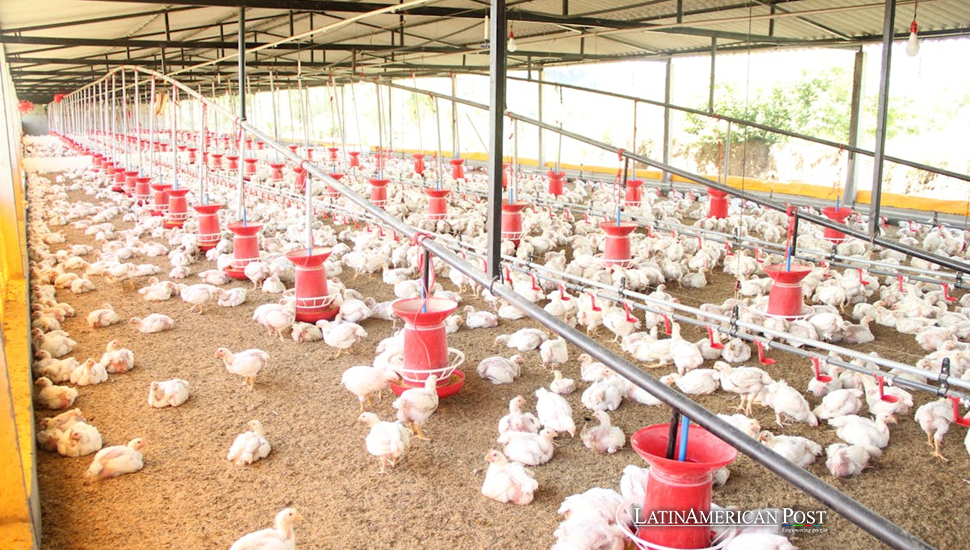How Bird Flu is Reshaping South America’s Poultry Industry

The highly pathogenic avian influenza (HPAI) H5N1 has emerged as a defining challenge for South America’s poultry sector. Since its first detection in late 2022, this viral strain has triggered unprecedented changes across the continent’s poultry industry, forcing rapid adaptations in production methods and biosecurity measures.
The Global Context
The current HPAI H5N1 clade 2.3.4.4b epizootic represents one of the most significant avian health crises in recent history. Its impact spans 67 countries across five continents, resulting in the loss of over 131 million domestic poultry through mortality and culling measures. This global outbreak began in 2020 and has demonstrated unprecedented geographical reach and severity.
When the virus reached South American shores in late 2022, it marked a critical turning point for the region’s poultry sector. The continent’s unique geography and climate conditions and significant role in global poultry production created distinct disease management and control challenges.
Current Landscape in South America
The virus’s spread pattern in South America follows migratory bird routes, particularly along the Pacific coast. Wild waterfowl serve as natural reservoirs, carrying the virus across borders and ecological boundaries. This transmission pattern has proven particularly challenging for containment efforts as wild bird movements remain beyond human control.
Notable outbreaks have occurred in several key poultry-producing regions. Peru reported its first cases in late 2022, followed by the outbreaks in Chile, Argentina, and Brazil. The virus has affected not only domestic poultry but also various wildlife species. Marine mammals along the Pacific coast have experienced unprecedented mortality rates, while shorebirds face significant population impacts.
The recent development of HPAI H5N1 infection in dairy cattle in the United States has raised new concerns about the virus’s adaptive capabilities. This unprecedented spread to mammals has prompted increased vigilance in South American livestock sectors, particularly in regions with nearby animal production systems.
Economic Ramifications
Before HPAI’s arrival, South America’s poultry industry showed robust growth, with Brazil leading as the world’s largest poultry exporter. Annual production figures reached millions of metric tons, supporting domestic food security and international trade.
Post-outbreak statistics reveal significant disruptions. Affected regions have experienced production declines ranging from 20% to 40%, depending on outbreak severity and control measures. These reductions have rippled the supply chain, affecting feed producers, equipment suppliers, and transportation services.
The regional poultry industry’s significance extends beyond direct economic impact. It provides affordable protein to millions of consumers and supports numerous rural communities through employment and auxiliary services. The sector’s destabilization threatens both food security and rural livelihoods.
Trade restrictions have perhaps caused the most severe economic impact. Many importing countries imposed temporary bans on poultry products from affected South American regions, leading to market disruptions and price volatility. Some producers have been forced to redirect export products to domestic markets, creating oversupply and pricing pressures.
Industry Response and Adaptation
South American poultry producers have implemented enhanced biosecurity protocols, often exceeding pre-existing standards. These measures include:
- Restricted access to production facilities
- Enhanced cleaning and disinfection procedures
- Strict personnel protective equipment requirements
- Modified ventilation systems
- Improved waste management protocols
Disease surveillance systems have undergone significant upgrades. New monitoring networks combine traditional surveillance methods with advanced technologies, including:
- Real-time reporting systems
- Geographic information system mapping
- Automated alert mechanisms
- Enhanced laboratory testing capabilities
Emergency response plans have evolved to address the unique challenges posed by HPAI. These plans emphasize rapid detection, swift containment measures, and coordinated response actions. Many facilities have established dedicated crisis management teams and conducted regular drills to maintain readiness.
Risk Management Strategies
HPAI prevention remains the primary defense against the virus. Current strategies focus on multiple layers of protection:
- Physical barriers between domestic flocks and wild birds
- Enhanced biosecurity training for personnel
- Regular health monitoring programs
- Strategic facility location planning
Contingency planning has become more sophisticated, incorporating lessons learned from initial outbreaks. These plans now account for various scenarios, including:
- Different outbreak scales
- Various transmission patterns
- Multiple affected species
- Supply chain disruptions
- Market access restrictions
Laboratory testing capabilities have expanded significantly across the region. Many countries have invested in new equipment and training for rapid, accurate diagnosis. This infrastructure improvement supports both routine surveillance and emergency response efforts.
Future Prospects
Industry forecasts suggest a gradual recovery, though with lasting changes to operational practices. Experts predict increased investment in automation and biosecurity infrastructure, potentially leading to industry consolidation as smaller producers struggle with compliance costs.
Preparedness improvements continue to evolve, with emphasis on:
- Advanced warning systems
- Improved stakeholder coordination
- Enhanced training programs
- Updated response protocols
Regional cooperation initiatives have strengthened, recognizing that effective disease control requires coordinated action. New partnerships between countries, research institutions, and industry organizations provide frameworks for information sharing and joint response efforts.
Long-term sustainability measures focus on building resilience through:
- Diversified production systems
- Enhanced genetic diversity in breeding stock
- Improved farm management practices
- Strengthened biosecurity infrastructure
The transformation of South America’s poultry industry continues as it adapts to the persistent threat of HPAI. While challenges remain significant, the sector’s response demonstrates remarkable resilience and innovation. Though born from crisis, these adaptations may strengthen the industry’s long-term sustainability and competitive position in global markets.
Success in managing HPAI will require ongoing vigilance and adaptation. The industry’s future depends on maintaining effective biosecurity measures while meeting the growing demand for poultry products. This balance between safety and productivity will likely define the sector’s development in the coming years.
The reshaping of South America’s poultry industry represents both challenge and opportunity. While HPAI has forced difficult changes, it has accelerated modernization and improved industry practices. These developments position the sector for greater resilience and sustainability when facing future challenges.
References:
- The “bird flu” threat and a functional emergency response plan. IICA.INT. (n.d.). https://iica.int/en/press/news/bird-flu-threat-and-functional-emergency-response-plan
- Azevedo, D. (2022, December 12). Avian influenza spreads in South America. Poultry World. https://www.poultryworld.net/health-nutrition/health/avian-influenza-spreads-in-south-america/
- Tomas, G., Marandino, A., Panzera, Y., Rodriguez, S., Wallau, G. L., Dezordi, F. Z., Perez, R., Bassetti, L., Negro, R., Williman, J., Uriarte, V., Grazioli, F., Leizagoyen, C., Riveron, S., Coronel, J., Bello, S., Paez, E., Lima, M., Mendez, V., & Perez, R. (2024, April 13). Highly pathogenic avian influenza H5N1 virus infections in pinnipeds and seabirds in Uruguay: Implications for bird–mammal transmission in South America. OUP Academic. https://academic.oup.com/ve/article/10/1/veae031/7645834?login=false





